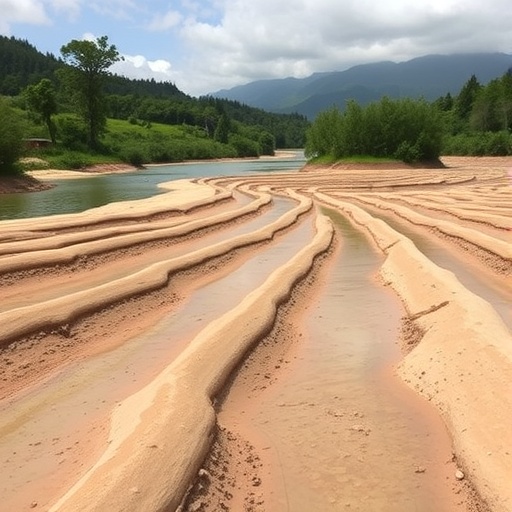In the heart of the central highlands of Ethiopia lies the Urago micro-watershed, a region marked by rich biodiversity and agricultural potential. However, it has not been exempt from the pervasive issue of soil erosion, a natural process that, when amplified by human activity, can drastically undermine the health and productivity of the land. Recent research by Endrias, Assen, and Legass has shed light on the dynamics of soil erosion within this critical area, focusing particularly on how different watershed management practices influence soil stability.
The research emphasizes the vital role that watershed management practices play in minimizing soil erosion. These practices encompass a range of strategies designed to enhance soil conservation, improve water retention, and, ultimately, safeguard the agricultural productivity of the region. The study systematically investigates how variations in these practices can lead to differing erosion rates, providing valuable insights necessary for formulating effective management policies.
Historical data suggests that soil erosion is one of Ethiopia’s most significant environmental challenges. It is estimated that millions of tons of fertile soil are lost each year due to factors including deforestation, overgrazing, and poor agricultural practices. In the Urago micro-watershed, where agriculture forms the backbone of the local economy, the implications are particularly concerning. Eroded soils not only reduce agricultural yields but also compromise the quality of the region’s water resources, leading to a cascading effect that threatens both food security and ecological balance.
The researchers utilized a combination of field surveys, remote sensing technology, and hydrological modeling to assess the erosion dynamics in Urago. In doing so, they were able to establish critical relationships between the intensity of various management practices and the subsequent rates of soil erosion observed throughout the watershed. This rigorous approach underscored the multifactorial nature of soil erosion, which can be influenced by climatic variables, land-use patterns, and the prevailing land management strategies employed by farmers in the area.
Among the management practices investigated, contour farming and reforestation emerged as particularly effective in curbing soil loss. By cultivating crops along the contours of the land rather than up and down slopes, contour farming significantly reduces surface runoff, allowing rainwater to permeate the soil and nourish crops. Similarly, reforestation not only protects the soil from wind and rain but also enhances biodiversity, thus contributing to a healthier ecosystem overall.
Interestingly, the research also highlighted the importance of community engagement and local knowledge in the implementation of these practices. Engaging local farmers in discussions about soil conservation measures ensures that the methods adopted are not only scientifically sound but also culturally acceptable. When community stakeholders are consulted and involved in decision-making processes, they are more likely to embrace and sustain the practices over time, thus amplifying their impact.
Furthermore, the study illuminated how climate variability affects soil erosion rates. Changing weather patterns, including increased rainfall intensity, have been observed in the region and pose additional challenges to soil management strategies. For instance, extreme rainfall events can exacerbate erosion by overwhelming inadequate soil conservation measures. Therefore, it becomes imperative for land management policies to incorporate adaptive strategies that accommodate the ongoing impacts of climate change.
In addition to providing crucial data on erosion dynamics, the research offers a pathway toward developing more resilient agricultural systems. By documenting the efficacy of specific watershed management practices, it sets a benchmark for future studies aimed at mitigating soil erosion across similar terrains in Ethiopia and beyond. Policymakers are thus encouraged to leverage these insights to formulate comprehensive land and water management policies that prioritize sustainability.
The implications of these findings extend beyond the Urago micro-watershed. They serve as a compelling case for the necessity of integrating soil conservation techniques into agricultural practices across regions facing similar ecological challenges. As countries worldwide grapple with food security issues exacerbated by environmental degradation, adopting effective and context-specific management practices found in the study becomes crucial.
In conclusion, the research conducted by Endrias, Assen, and Legass not only contributes valuable knowledge to the field of soil erosion dynamics but also underscores the urgent need for effective watershed management practices. It provides a framework for understanding the interaction between land management strategies and soil health, paving the way for more sustainable agricultural systems. As the world seeks solutions to counteract environmental challenges, the lessons learned from the Urago micro-watershed could be transformative, helping to secure the future of agriculture in Ethiopia and similar regions worldwide.
As the authors contend, addressing soil erosion is not merely an environmental issue; it is also a matter of economic stability and food security for millions. Therefore, as we look forward, the integration of scientific research with traditional wisdom and modern practices promises to foster resilient communities equipped to face the challenges posed by soil erosion and climate change.
Subject of Research: Soil erosion dynamics in response to watershed management practices.
Article Title: Soil erosion dynamics in response to watershed management practices in Urago micro-watershed, central highland of Ethiopia.
Article References:
Endrias, M., Assen, M. & Legass, A. Soil erosion dynamics in response to watershed management practices in Urago micro-watershed, central highland of Ethiopia.
Discov Sustain 6, 882 (2025). https://doi.org/10.1007/s43621-025-01259-w.
Image Credits: AI Generated
DOI: 10.1007/s43621-025-01259-w
Keywords: Soil erosion, watershed management, sustainable agriculture, Ethiopia, land conservation practices, community engagement, climate change adaptation.




